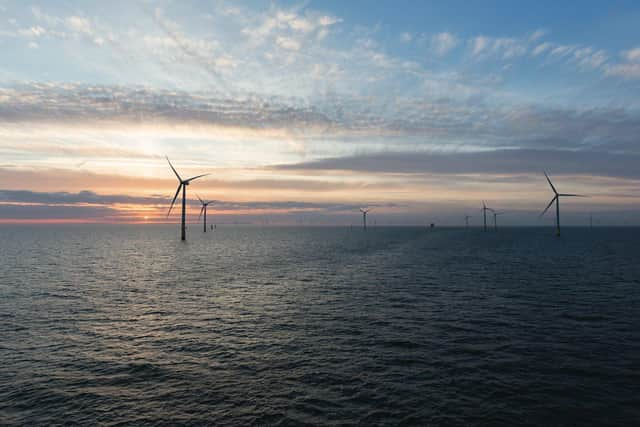Orsted: renewable energy vital for future generations


It has been heartening to observe that the determination from governments in the UK, Scotland and across the world to maintain their climate ambitions in the face of the Covid-19 pandemic.
There is a clear understanding that accelerating the transition to a low-carbon economy can both drive our economic recovery and build resilience for the future.
In the past few months, not only have we had the Prime Minister’s Ten Point Plan for a Green Industrial Revolution, but also confirmation from the Scottish Government of an increased installed offshore wind target of 11GW by 2030. We also have the timetable for Crown Estate Scotland’s ScotWind leasing round, as part of its suite of actions to hit net-zero by 2045.


This net-zero target is challenging but achievable. It is going to take social and political will to achieve a transition that will touch on almost all aspects of our society and economy – how we create energy, how we heat our homes and businesses, how we power transport, and how we manufacture goods and products. And it will require a huge amount of investment – in terms of both finance and time – and thought from our best engineers, academics and behaviour change scientists.
But this investment offers an opportunity as well as a challenge. Because, as we create the economic stimulus that we need to help pull us out of this incredibly difficult period, we know where it needs to be invested – in green and sustainable businesses and technologies. This investment is going to be essential in the coming years – so let’s use this chance to kick-start the next stage of the transformation that we need, creating jobs and further investment as we go.
The renewable energy technologies that we need to fundamentally transform the energy system and radically reduce emissions are at our disposal – and they are cost-efficient. The significant cost reductions in offshore wind demonstrate how governments setting clear and ambitious targets provide investment visibility for the private sector, which again drives innovation, cost reductions, and large-scale deployment.
When governments set ambitious targets and enact clear policies which create investor certainty, it enables the private sector to further accelerate the build-out of green energy. And it is this kind of vision we are seeing in Scotland and the rest of the UK.
Jobs and regeneration
A Green Recovery is not just about helping mitigate climate change or supporting one particular technology, it is also the catalyst for creating hundreds of thousands of long-term skilled jobs. It will boost the UK’s supply chain companies, support the regeneration of coastal communities and create low-carbon energy for traditional industries that already employ many hundreds of thousands of skilled workers. Industries in regions such as Fife, the Humber, Teesside and more.
In Grimsby on the Humber Estuary, my company – Danish multinational power firm Ørsted – has created the world’s largest operations and maintenance base. It employs more than 400 technicians at the Ørsted facility alone, and supports many thousands more in local supply chains.
In total, we have invested in excess of £1 billion in the Humber region to date, bringing long-term employment, training, investment and community support. And we are seeing this mirrored in other hubs, including on the Forth, the Tay and in the North East of Scotland.
Grimsby and the wider Humber area is now known globally as a leader in offshore wind technology – at the Ørsted facility, we have welcomed delegations from all over the world to discuss best practice and how they might follow the lead that the UK has set.
This world leading position in offshore wind is something Scotland and the UK can be rightfully be proud of. We are now seeing more and more major projects being constructed in Scotland, and with them the creation of operations hubs. The industry is also poised for the development of commercial-scale floating offshore wind generation, where the Scottish supply chain has a cutting edge.
Offshore wind and the challenges of a 2030 target
This is an exciting time for the renewable energy – and offshore wind energy in particular – in the UK, and the pledge that offshore wind will be the backbone of the UK’s electricity system by 2030, is a welcome boost in the battle against climate change.
At Ørsted, we estimate that this will bring about £50bn of investment for the UK, many tens of thousands of jobs across the sector, and help achieve the UK’s legally binding 2050 net-zero target.
So what more needs to happen for the offshore wind sector to reach its potential?
The renewed commitment to achieving 11GW of installed offshore wind in Scotland and 40GW around the UK by 2030 represents a huge opportunity for the country. It is a target which I firmly believe is achievable, but we shouldn’t be under any illusions about the scale of the challenge.
We currently have about 10GW of offshore wind capacity in UK waters, with 900MW of that around Scotland. A further 10GW is consented, either already in construction or on its way, following a contracts for difference award. More than 4GW of this will be in Scotland.
We need to double this again in the next ten years if we are to achieve the UK target, and several regulatory and technical barriers need to be overcome.
Additional seabed leasing, structured support for UK supply chain companies, development of windfarm-compliant military and civil radar systems, building the transmission infrastructure required to connect large-scale renewable electricity, and the development of new guidance on sustainable development are just some of the crucial elements needed to unlock this exciting future for the sector and the country.
All of these are what I consider to be ‘challenges of success’ – the industry has grown so rapidly that, while in the past it has fitted in round the edges of existing industries and institutions, it is now so large that we need to rethink how we use the marine landscape in order to facilitate offshore wind.
And we need to do this in a way that is fair to existing users of the sea, such as oil and gas and the fishing industry, and one which is environmentally sustainable and sensitive to marine habitats.
The 40GW target will only be possible if government, the offshore wind industry and environmental stakeholders can come together, as we did to deliver the Offshore Wind Sector Deal, to ensure new wind farms can be consented responsibly and in a reasonable timeframe.
Ørsted is committed to working alongside our industry colleagues and stakeholders to determine a clear route for delivery of offshore wind at scale that is sustainable and that protects the environment.
Climate change is a defining challenge of our time and it is already having a clear impact on the ecosystems in our seas and oceans. The world needs to reduce global carbon emissions by 50 per cent towards 2030 to stay within a 1.5ºC increase in global warming. Large-scale renewable projects, such as Ørsted’s Hornsea Three, Vattenfall’s Norfolk Vanguard and Boreas, or SSE’s Berwick Bank, will be instrumental to the UK and Scotland delivering on their net-zero targets. Each one of these projects can provide power to millions of homes, limiting the negative consequences of climate change and the threat it poses to the environment.
Ensuring that ambitious, world-leading projects like these can go ahead in a way that leaves minimal impact on the environment is essential if we are to maintain the strong story the UK has to tell about its commitment to addressing climate change. It is also vital if we are to avoid the potential economic consequences of delaying projects that are key to hitting our 2050 net-zero target.
Offshore wind and complementary technology
Offshore wind can also contribute to decarbonising heat, transport, and industrial processes – renewable hydrogen is a good example of a new technology that can enable large-scale industrial decarbonisation.
Now is the time for UK companies to innovate in the technologies that will put British firms at the forefront of the renewable hydrogen revolution – from more efficient electrolysers to stackable designs and high-volume manufacturing that can follow the industrialisation and cost-reduction route that offshore wind has taken.
There is huge potential for Scotland in renewable hydrogen and a strong indication from the Scottish Government that it uis keen to see hydrogen projects succeed.
Renewable hydrogen will also complement carbon capture and storage – a decarbonisation technology that similarly provides a huge opportunity for Scottish industry.
The good news is that there are exciting opportunities to realise this potential almost immediately, through the forthcoming Offshore Wind Leasing Round 4 and the ScotWind leasing round. Covid-19 has given us an opportunity to refocus and, if we make the right choices now, potentially accelerate our progress to a more sustainable, low-carbon future.
The offshore wind sector will play a prominent role in this future and I am confident that, through continued collaboration between government, the renewables industry and business, we can deliver environmental and economic benefits for generations to come.